自考外语教学法之认知法
认知法

认知法一、定义:认知法又称认知-符号法(Cognitive-Code Approach),产生于60年代的美国,代表人物是卡鲁尔、布鲁纳。
它强调人能够进行感知、记忆、分析、综合、判断、推理等一系列智能活动,它符合现代外语教学“以学习者为中心”的特点,因此受到不少人的推崇。
关于认知法的理论来源,尚不清楚,但可以肯定的是,它不是来自于某一派的理论,而是几种理论的汇合,例如,60 年代初瑞士心理学家皮亚杰 (JeanP iaget )创立的“发生认知论”及另一位心理学家布鲁纳(J. S . B runer)提出的“基本结构”和“学习者为中心”的理论对其形成产生了巨大影响。
皮亚杰认为,掌握新知识是一种智力活动,而每种智力活动都包含一定的认知结构。
无论是接受刺激还是对刺激作出反应都是受认知结构支配的。
布鲁纳的“基本结构”即指概念、基本原理、规则等,在教学过程中应让学生掌握。
学生掌握基本结构,更易于理解本学科,有助于在记忆中长期保持所学的知识。
随后,乔姆斯基(NoamChom sky)提出,语言学习不是单纯的模仿,而是掌握规则、记忆的过程,是一种创造性的活动,人们可以利用有限的规则创造出无限的句子。
而认知心理学家奥斯贝尔(D. P. A u subel)也提出了“有意义学习理论”,即认知学习,它与机械性实习中的囫囵吞枣,死记硬背不同,它强调学生对所学基本规则和概念理解,了解其内在联系, 促进记忆, 认识是学习的开始, 并以理解为目的。
他反对外语学习中的模仿的操练, 主张在理解基础之上的操练, 受到了上述几种思潮的影响,认知法认为,成千人学习外语与幼儿学习母语相比,有不同的特点:1.缺乏幼儿学习母语的语言环境,是在人为的语言环境(教室)中学习的;2.学生是在掌握了母语的基础上学习外语的;3.学习是自觉的、有意识、有组织的。
根据这些特点,把外语教学过程分为三个阶段:语言的理解(comprehension)、语言能力(competence)、语言运用(performance)。
认知教学法

背景 理论基础
认知教学法
教学特点 教学过程 评价
定 义
• 认知教学法(cognitive approach),也被 称为“认知一符号法”。它以认知心理学 为理论依据,重视感知、理解、逻辑思维 等智力活动在获取知识过程中的积极作用, 强调对语言规则的理解,重视语言教学中 母语与外语的交叉对比作用,着眼于培养 学生实际运用外语的语言综合能力。
掌握了母语的语言技能和 语言知识
是一个在母语环境中耳濡 目染、自然感知、潜移默 化、水到渠成的过程
自觉的、有意识的和有组织 的前提下进行的
认知法将外语教学过程分为以下三个阶段
语言的理解 培养语言综合能力 语言的运用
(一)语言的理解
• 理解,就是让学生理解教师讲授的或提供 的语言材料和语言规则的意义、构成和用 法。 • 理解是学生从事一言语活动的基础,学生 的一切语言操练都应建立在理解言语材料 的基础上。这样才能构成“有意义的学 习”。 • 认知法要求学生对新的语言规则的理解, 不是靠教师的讲解,而是在教师的指导和 启发下,通过学生自己去发现语法规则。
• 20世纪 年代由美国心理学家卡鲁尔 世纪60年代由美国心理学家卡鲁尔 世纪 (J.B.Carroll)首先提出了认知法。 首先提出了认知法。 首先提出了认知法 • 卡鲁尔认为:第二语言是一种知识体系, 卡鲁尔认为:第二语言是一种知识体系, 外语学习主要是通过对外语的语音、词汇、 外语学习主要是通过对外语的语音、词汇、 语法的分析来理解和掌握语言结构。 语法的分析来理解和掌握语言结构。而语 言的运用将会随着语言在情景中的使用而 得到发展。 得到发展。
认知主义教学法
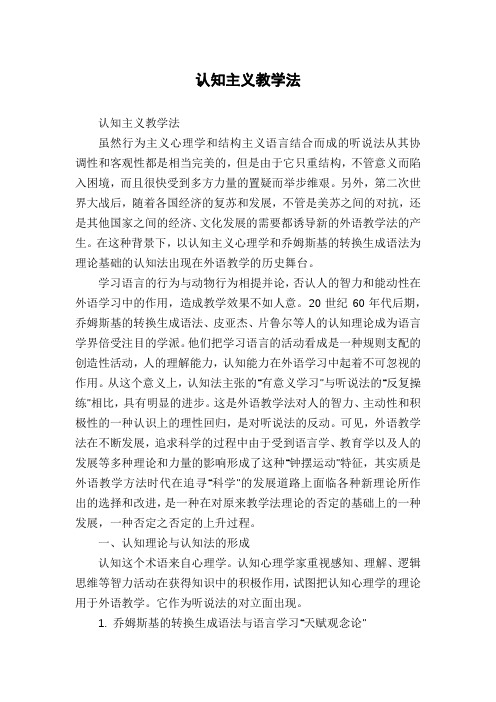
认知主义教学法认知主义教学法虽然行为主义心理学和结构主义语言结合而成的听说法从其协调性和客观性都是相当完美的,但是由于它只重结构,不管意义而陷入困境,而且很快受到多方力量的置疑而举步维艰。
另外,第二次世界大战后,随着各国经济的复苏和发展,不管是美苏之间的对抗,还是其他国家之间的经济、文化发展的需要都诱导新的外语教学法的产生。
在这种背景下,以认知主义心理学和乔姆斯基的转换生成语法为理论基础的认知法出现在外语教学的历史舞台。
学习语言的行为与动物行为相提并论,否认人的智力和能动性在外语学习中的作用,造成教学效果不如人意。
20世纪60年代后期,乔姆斯基的转换生成语法、皮亚杰、片鲁尔等人的认知理论成为语言学界倍受注目的学派。
他们把学习语言的活动看成是一种规则支配的创造性活动,人的理解能力,认知能力在外语学习中起着不可忽视的作用。
从这个意义上,认知法主张的“有意义学习”与听说法的“反复操练”相比,具有明显的进步。
这是外语教学法对人的智力、主动性和积极性的一种认识上的理性回归,是对听说法的反动。
可见,外语教学法在不断发展,追求科学的过程中由于受到语言学、教育学以及人的发展等多种理论和力量的影响形成了这种“钟摆运动”特征,其实质是外语教学方法时代在追寻“科学”的发展道路上面临各种新理论所作出的选择和改进,是一种在对原来教学法理论的否定的基础上的一种发展,一种否定之否定的上升过程。
一、认知理论与认知法的形成认知这个术语来自心理学。
认知心理学家重视感知、理解、逻辑思维等智力活动在获得知识中的积极作用,试图把认知心理学的理论用于外语教学。
它作为听说法的对立面出现。
1. 乔姆斯基的转换生成语法与语言学习“天赋观念论”1957年,乔姆斯基(Noam Chomsky)出版了第一部著作《句法结构》,本书正式提出转换生成语法理论。
此后连续出版了《句法理论要略》(1965),《笛卡儿语言学》(1966),《语言和心理》,这些作品的出版问世,标志着转换生成语法理论的产生和发展。
认知教学法在外语教学中的现代意义

认知教学法在外语教学中的现代意义随着全球化的不断推进和信息交流的加速,学习外语逐渐成为了当代青年的必修课,而作为教学方法的认知教学法也越来越受到了重视。
本文将从现代意义的角度,探讨认知教学法在外语教学中的应用。
一、认知教学法的简介认知教学法是指将学生视为一个“认知处理者”,重视学生的自主学习和思考能力,注重教师的引导与辅助,以培养学生自主学习能力为目的的一种教学方法。
该教学法强调探究性、互动性、个性化和终身学习的概念,以促进学生的认知理解和能力提高。
1.激发学生的自主学习能力在外语教学中,教师往往扮演着知识传授者和指导者的双重角色,而认知教学法则更多地强调帮助学生发挥自主学习的主体性。
采取认知教学法能够鼓励学生更加积极地参与学习,激发他们自主学习的能力和兴趣,从而在非正式的学习场所获得更多的学习量和经验。
2.提升学生的思考与理解能力外语学习进行过程中,学生通常需要面对较多的文化差异和思维方式的不同。
认知教学法鼓励学生通过各种思维方式去探索学习经验,并对学习材料进行深入思考与理解。
通过对外语语法、语言规则等知识进行深层次的认知处理,学生们可提高自己的语言能力,同时也增强了跨文化情商,培养了广泛而深刻的思维模式与方法。
3.培养学生的团队合作和沟通能力在学习外语的过程中,外语教学往往要求学生进行口头或书面的交流,而这就需要学生能够善于与人交往,灵活的运用语言进行沟通。
采取认知教学法,不仅能够使学生提高自身的思考和语言能力,更能够培养他们的团队合作和沟通能力,让学生们在交流中获得更多的成长。
三、结语认知教学法对外语教育的发展有着十分重要的现代意义。
它强调了学生自主学习、思考和理解的能力,也强调了团队沟通和协作的重要性。
因此,采取认知教学法,可以帮助学生更好地掌握和发展语言能力,培养跨文化素质和批判性思维,更有利于学生在未来的职业发展中取得成功。
英语认知教学法
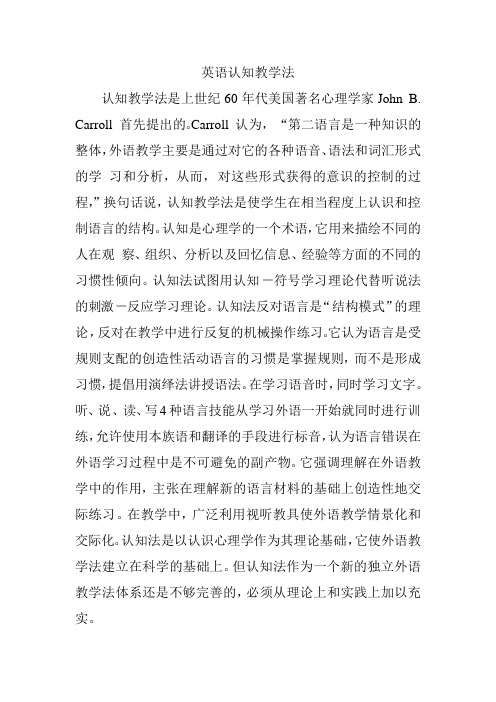
英语认知教学法认知教学法是上世纪 60 年代美国著名心理学家 John B. Carroll 首先提出的。
Carroll 认为,“第二语言是一种知识的整体,外语教学主要是通过对它的各种语音、语法和词汇形式的学习和分析,从而,对这些形式获得的意识的控制的过程,”换句话说,认知教学法是使学生在相当程度上认识和控制语言的结构。
认知是心理学的一个术语,它用来描绘不同的人在观察、组织、分析以及回忆信息、经验等方面的不同的习惯性倾向。
认知法试图用认知-符号学习理论代替听说法的刺激-反应学习理论。
认知法反对语言是“结构模式”的理论,反对在教学中进行反复的机械操作练习。
它认为语言是受规则支配的创造性活动语言的习惯是掌握规则,而不是形成习惯,提倡用演绎法讲授语法。
在学习语音时,同时学习文字。
听、说、读、写 4 种语言技能从学习外语一开始就同时进行训练,允许使用本族语和翻译的手段进行标音,认为语言错误在外语学习过程中是不可避免的副产物。
它强调理解在外语教学中的作用,主张在理解新的语言材料的基础上创造性地交际练习。
在教学中,广泛利用视听教具使外语教学情景化和交际化。
认知法是以认识心理学作为其理论基础,它使外语教学法建立在科学的基础上。
但认知法作为一个新的独立外语教学法体系还是不够完善的,必须从理论上和实践上加以充实。
在外语教学时,我们应该在认知教学法的指导下,让学生多接触一些语言材料,包括一些他们尚不能运用的语言材料,让他们吸收新的养分,以丰富所学的外语。
认知心理学的一个基本原则是:在认知发展过程中,新的学习任务是在已经掌握的知识的基础上进行的,所以,我们要注意从学生已有的知识出发,传授新的知识。
母语是学生共有的知识,应在教学中广加利用,必要时可将本族语与外语作比较,帮助学生理解语言现象,所以没有必要排斥母语。
认知科学把人类的知识分为陈述性知识和程序性知识。
陈述性知识是关于事实本身的知识,以语义网络的形式保存在人的记忆里。
认知教学法在外语教学中的现代意义

认知教学法在外语教学中的现代意义我们来谈谈认知教学法的基本理念。
认知教学法是一种教学方法,强调学生的主动参与和对知识的理解和运用。
它认为学生在学习过程中应该成为知识的主人,而不是被动地接受知识。
认知教学法强调学生的思维过程,注重对学习者的理解和认知过程的引导和促进,以达到知识的深度和有效掌握。
在外语教学中,认知教学法有着显著的现代意义。
外语教学的目标是培养学生的语言交际能力。
而传统的语法翻译法和听说读写训练法往往强调对语言形式的掌握,忽视了语言的功能和意义。
而认知教学法则注重学生的语言运用能力,鼓励学生通过实际的语言交际活动来提高语言能力,从而更好地适应使用外语的实际需要。
认知教学法强调对学习者的理解和认知过程的引导和促进。
在外语教学中,学生的语言和文化背景差异较大,他们对新知识的接受和理解也存在较大差异。
而传统的教学方法往往以教师为中心,忽视了学生个体差异的处理。
认知教学法则重视学生的认知差异,强调课堂教学需要针对不同学生的认知特点进行差异化教学,以促进每个学生都取得有效的学习效果。
认知教学法注重学生参与和建构知识的过程。
在外语教学中,学生的学习兴趣和主动性对于提高学习效果和培养学生的语言能力至关重要。
而传统的教学方法往往过于强调教师的指导和控制,忽视了学生的主体地位。
认知教学法则注重学生的主动参与和建构知识的过程,鼓励学生通过实际的语言实践来提高语言能力,增强语言学习的积极性和主动性。
在实际外语教学中,认知教学法的具体应用可以包括以下几个方面。
教师需要根据学生的认知特点进行差异化教学,了解并充分利用学生的语言背景和语言能力,避免一刀切的教学方式。
教师需要注重学生的语言实践和交际能力的培养,鼓励学生通过对实际语言环境的参与来提高语言能力和交际能力。
教师需要鼓励学生主动参与课堂活动,培养学生的自主性和批判性思维,引导学生从被动的接受者转变为主动的学习者。
认知教学法在外语教学中具有重要的现代意义,它强调学生的主体地位,注重学生的认知特点和个体差异,鼓励学生的自主学习和批判性思维。
浅谈认知法外语教学理论
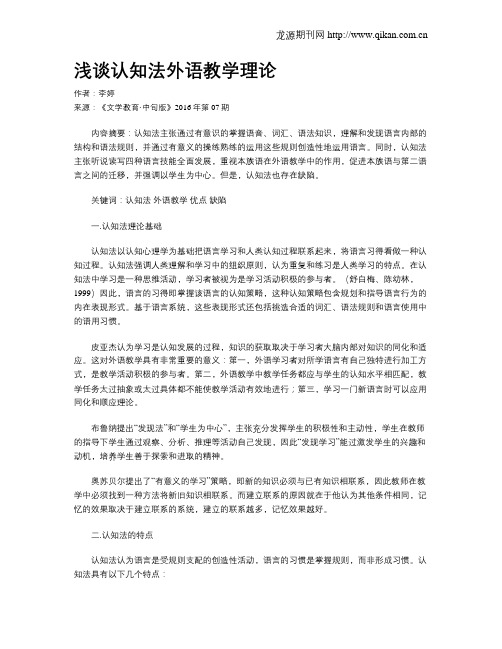
浅谈认知法外语教学理论作者:李婷来源:《文学教育·中旬版》2016年第07期内容摘要:认知法主张通过有意识的掌握语音、词汇、语法知识,理解和发现语言内部的结构和语法规则,并通过有意义的操练熟练的运用这些规则创造性地运用语言。
同时,认知法主张听说读写四种语言技能全面发展,重视本族语在外语教学中的作用,促进本族语与第二语言之间的迁移,并强调以学生为中心。
但是,认知法也存在缺陷。
关键词:认知法外语教学优点缺陷一.认知法理论基础认知法以认知心理学为基础把语言学习和人类认知过程联系起来,将语言习得看做一种认知过程。
认知法强调人类理解和学习中的组织原则,认为重复和练习是人类学习的特点。
在认知法中学习是一种思维活动,学习者被视为是学习活动积极的参与者。
(舒白梅、陈幼林,1999)因此,语言的习得即掌握该语言的认知策略,这种认知策略包含规划和指导语言行为的内在表现形式。
基于语言系统,这些表现形式还包括挑选合适的词汇、语法规则和语言使用中的语用习惯。
皮亚杰认为学习是认知发展的过程,知识的获取取决于学习者大脑内部对知识的同化和适应。
这对外语教学具有非常重要的意义:第一,外语学习者对所学语言有自己独特进行加工方式,是教学活动积极的参与者。
第二,外语教学中教学任务都应与学生的认知水平相匹配,教学任务太过抽象或太过具体都不能使教学活动有效地进行;第三,学习一门新语言时可以应用同化和顺应理论。
布鲁纳提出“发现法”和“学生为中心”,主张充分发挥学生的积极性和主动性,学生在教师的指导下学生通过观察、分析、推理等活动自己发现,因此“发现学习”能过激发学生的兴趣和动机,培养学生善于探索和进取的精神。
奥苏贝尔提出了“有意义的学习”策略,即新的知识必须与已有知识相联系,因此教师在教学中必须找到一种方法将新旧知识相联系。
而建立联系的原因就在于他认为其他条件相同,记忆的效果取决于建立联系的系统,建立的联系越多,记忆效果越好。
二.认知法的特点认知法认为语言是受规则支配的创造性活动,语言的习惯是掌握规则,而非形成习惯。
5、现代外语教学法--认知法

认知法六十年代,科学技术飞速发展,国际间的竞争深入到科技领域。
科技情报的交流、国际间的交往,都需要高级外语人才。
美国卡鲁尔提出了认知法(Cognitive Approach)。
乔姆斯基的转换生成语法、布鲁纳的知识结构论对认知法有极大地影响。
乔姆斯基提出语言有深层结构和表层结构,语言的深层结构决定它的表层结构;布鲁纳认为掌握了基本原理,学生不但记得牢,而且有再生的功能。
认知法把语言学习看作是智力活动。
语言是人类所独有的交际工具,智力在语言的产生和学习中起作用,在语言教学里充分发挥智力作用是必要的。
认知法把儿童学习语言的天赋才能解释为儿童脑里存有着潜在的“普遍语法”。
任何语言里的句子都是无穷无尽的,人不可能学到每个句子,但在学习的过程中,却能听懂和应用从未学过的或见过的句子,这就是智力或语法在起作用。
1、认知法的特点1)认知法认为儿童是利用信息语言的才能,或头脑里潜在的“普遍语法”学习语言的。
2)在教学中,认知法强调理解,强调学习法,反对单纯依靠机械操练来培养语言习惯。
3)学生是利用他所掌握的本族语和本族语语法来学习外语的。
认知法在对待本族语的问题上,强调通过本族语和外语的对比和分析,找出两种语言中相同、相似和相异的地方,从中确定学生在外语学习力的难点和重点,并建立外语教学方法的体系。
2、认知法的优点1)重视发展学生的智力因素,激励学生积极思维、创造性地实行交际活动。
2)重视调动学生的积极性,激发学生的学习动机,掌握科学学习方法,养成良好的学习习惯,积极参加外语交际活动。
3)克服语法翻译法的单纯强调培养阅读水平、依靠母语,不重视培养外语交际水平的极端片面性。
3、认知法的缺点1)过度强调要在认知法规则基础上实行外语教学的观点未必科学。
2)认知法作为一种外语教学法体系,需要在理论上和实践上进一步论证。
认知教学法在外语教学中的现代意义

认知教学法在外语教学中的现代意义一、认知教学法的概念认知教学法是一种以认知心理学理论为基础的教学方法。
该方法强调理解、记忆、运用和评价等认知过程的重要性,注重学生的主动参与和自主学习。
认知教学法的核心理念是通过激发学生的思维活动,提高他们的学习能力和自主学习能力,使他们成为具有批判性思维和问题解决能力的学习者。
二、认知教学法的原则1. 学习者的主体地位认知教学法强调学生的主体地位,注重学生的个性和学习特点。
教师应该关注学生的认知过程和学习需求,激发学生的兴趣和动机,激发他们的学习潜能和创造力。
2. 启发式教学认知教学法主张采用启发式教学方法,引导学生进行自主探究和发现,培养学生的分析能力和解决问题能力。
通过启发式教学,学生可以更深入地理解和应用所学知识,提高学习效果和学习成就。
3. 知识的整合和迁移认知教学法重视知识的整合和迁移,强调学习的联系性和综合性。
教师应该帮助学生将已有的知识与新学习的知识进行整合,促进知识的迁移和应用,提高学习的有效性和实效性。
4. 反馈和调整认知教学法倡导及时的反馈和调整,鼓励学生通过犯错和反思来积极参与学习。
教师应该及时给予学生反馈,指导学生进行自我评价和自我调整,帮助他们不断完善和提高自己的学习策略和方法。
三、认知教学法在外语教学中的应用1. 激发学生的语言学习兴趣和动机在外语教学中,激发学生的语言学习兴趣和动机是至关重要的。
教师可以通过认知教学法的启发式教学方法,设计多样化的教学活动和课堂任务,引导学生进行实践性学习和情境性交流,激发他们的学习兴趣和动机。
3. 培养学生的语言学习策略和方法外语学习是一个长期的过程,学生需要掌握一定的学习策略和方法来提高学习效果和学习成就。
认知教学法倡导学生的自主学习和自我调整,教师可以帮助学生掌握有效的学习策略和方法,引导他们进行语言学习的反思和自我评价,提高他们的学习自觉性和自主性。
4. 提高学生的语言运用能力和语言思维能力外语学习的最终目的是让学生能够流利地运用所学语言进行交流。
认知法在英语教学中的应用
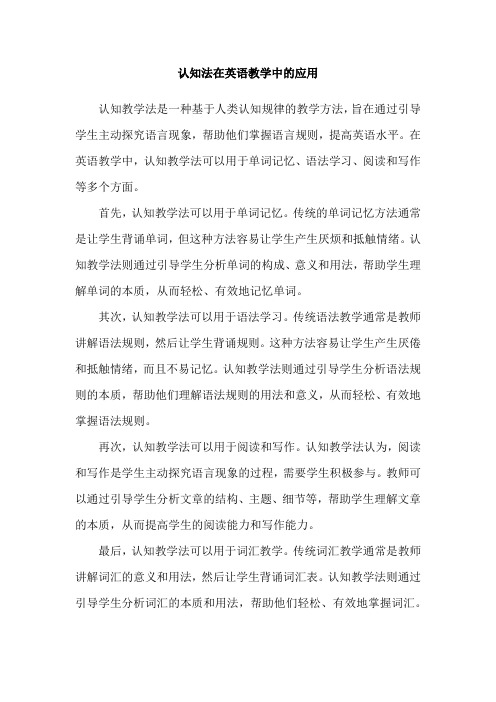
认知法在英语教学中的应用
认知教学法是一种基于人类认知规律的教学方法,旨在通过引导学生主动探究语言现象,帮助他们掌握语言规则,提高英语水平。
在英语教学中,认知教学法可以用于单词记忆、语法学习、阅读和写作等多个方面。
首先,认知教学法可以用于单词记忆。
传统的单词记忆方法通常是让学生背诵单词,但这种方法容易让学生产生厌烦和抵触情绪。
认知教学法则通过引导学生分析单词的构成、意义和用法,帮助学生理解单词的本质,从而轻松、有效地记忆单词。
其次,认知教学法可以用于语法学习。
传统语法教学通常是教师讲解语法规则,然后让学生背诵规则。
这种方法容易让学生产生厌倦和抵触情绪,而且不易记忆。
认知教学法则通过引导学生分析语法规则的本质,帮助他们理解语法规则的用法和意义,从而轻松、有效地掌握语法规则。
再次,认知教学法可以用于阅读和写作。
认知教学法认为,阅读和写作是学生主动探究语言现象的过程,需要学生积极参与。
教师可以通过引导学生分析文章的结构、主题、细节等,帮助学生理解文章的本质,从而提高学生的阅读能力和写作能力。
最后,认知教学法可以用于词汇教学。
传统词汇教学通常是教师讲解词汇的意义和用法,然后让学生背诵词汇表。
认知教学法则通过引导学生分析词汇的本质和用法,帮助他们轻松、有效地掌握词汇。
认知法教学方法
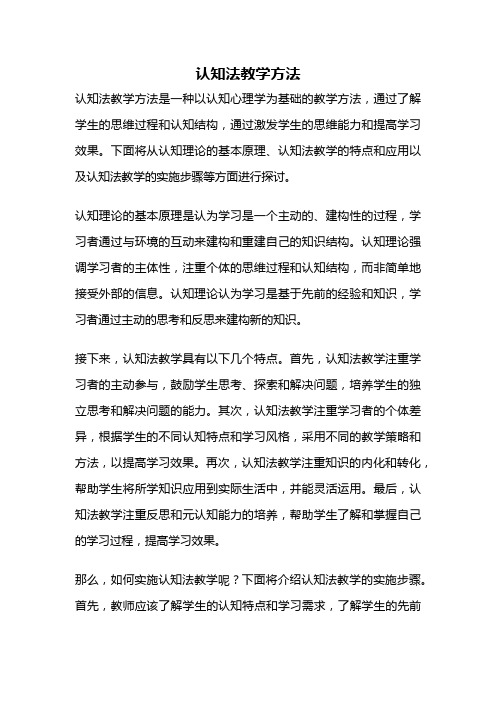
认知法教学方法认知法教学方法是一种以认知心理学为基础的教学方法,通过了解学生的思维过程和认知结构,通过激发学生的思维能力和提高学习效果。
下面将从认知理论的基本原理、认知法教学的特点和应用以及认知法教学的实施步骤等方面进行探讨。
认知理论的基本原理是认为学习是一个主动的、建构性的过程,学习者通过与环境的互动来建构和重建自己的知识结构。
认知理论强调学习者的主体性,注重个体的思维过程和认知结构,而非简单地接受外部的信息。
认知理论认为学习是基于先前的经验和知识,学习者通过主动的思考和反思来建构新的知识。
接下来,认知法教学具有以下几个特点。
首先,认知法教学注重学习者的主动参与,鼓励学生思考、探索和解决问题,培养学生的独立思考和解决问题的能力。
其次,认知法教学注重学习者的个体差异,根据学生的不同认知特点和学习风格,采用不同的教学策略和方法,以提高学习效果。
再次,认知法教学注重知识的内化和转化,帮助学生将所学知识应用到实际生活中,并能灵活运用。
最后,认知法教学注重反思和元认知能力的培养,帮助学生了解和掌握自己的学习过程,提高学习效果。
那么,如何实施认知法教学呢?下面将介绍认知法教学的实施步骤。
首先,教师应该了解学生的认知特点和学习需求,了解学生的先前知识和经验,以此为基础进行教学设计。
其次,教师应该设计一系列启发性的问题和情境,激发学生的思考和探索欲望,引导学生主动参与学习。
再次,教师应该提供适当的学习资源和工具,帮助学生获取所需的信息和知识。
同时,教师还应该提供必要的引导和支持,帮助学生解决问题和克服困难。
最后,在教学结束后,教师应该进行总结和反思,帮助学生回顾学习过程,巩固所学知识。
认知法教学方法是一种以认知心理学为基础的教学方法,通过了解学生的思维过程和认知结构,提高学习效果。
认知法教学注重学习者的主动参与、个体差异、知识内化和转化以及反思和元认知能力的培养。
在实施认知法教学时,教师应该了解学生的认知特点和学习需求,设计启发性的问题和情境,提供适当的学习资源和工具,并进行总结和反思。
tesol认知法 -回复
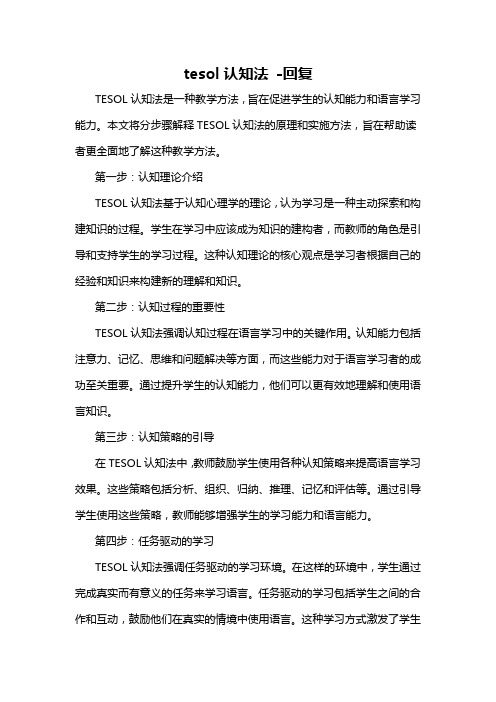
tesol认知法-回复TESOL认知法是一种教学方法,旨在促进学生的认知能力和语言学习能力。
本文将分步骤解释TESOL认知法的原理和实施方法,旨在帮助读者更全面地了解这种教学方法。
第一步:认知理论介绍TESOL认知法基于认知心理学的理论,认为学习是一种主动探索和构建知识的过程。
学生在学习中应该成为知识的建构者,而教师的角色是引导和支持学生的学习过程。
这种认知理论的核心观点是学习者根据自己的经验和知识来构建新的理解和知识。
第二步:认知过程的重要性TESOL认知法强调认知过程在语言学习中的关键作用。
认知能力包括注意力、记忆、思维和问题解决等方面,而这些能力对于语言学习者的成功至关重要。
通过提升学生的认知能力,他们可以更有效地理解和使用语言知识。
第三步:认知策略的引导在TESOL认知法中,教师鼓励学生使用各种认知策略来提高语言学习效果。
这些策略包括分析、组织、归纳、推理、记忆和评估等。
通过引导学生使用这些策略,教师能够增强学生的学习能力和语言能力。
第四步:任务驱动的学习TESOL认知法强调任务驱动的学习环境。
在这样的环境中,学生通过完成真实而有意义的任务来学习语言。
任务驱动的学习包括学生之间的合作和互动,鼓励他们在真实的情境中使用语言。
这种学习方式激发了学生的学习兴趣和自主学习能力。
第五步:反思和自主学习TESOL认知法鼓励学生进行反思和自主学习。
学生应该定期反思自己的学习过程和策略,分析自己的优点和不足,并制定改进计划。
这样的反思和自主学习能够帮助学生更好地利用认知策略和解决学习难题。
第六步:教师的角色在TESOL认知法中,教师的角色是指导者和支持者。
教师应该提供适当的学习任务和材料,引导学生使用认知策略,提供反馈和评估,同时鼓励学生的自主学习和合作学习。
教师需要关注学生的认知过程和学习策略,以便提供恰当的教学支持。
第七步:评估方法TESOL认知法的评估方法注重学生的综合能力评价。
除了传统的笔试和口试外,教师还可以使用学生的作业、小组讨论、项目作品和自我评估等方式来评估学生的认知能力和语言学习能力。
认知教学法在外语教学中的现代意义

认知教学法在外语教学中的现代意义一、认知教学法的基本理论认知教学法是建立在认知心理学的基础上的一种教学方法。
认知心理学认为人类的思维是一种复杂的认知活动,它涉及认知结构、认知过程和认知策略。
认知教学法主要包括以下几个理论基础:1)结构主义理论,强调知识结构的重要性;2)信息加工理论,强调学习者通过对信息的加工、组织和理解来学习;3)认知发展理论,强调学生的发展水平和潜在水平之间的差距。
这些理论为认知教学法在外语教学中的应用提供了理论基础。
二、认知教学法在外语学习中的应用1. 强调学生的积极参与和反思认知教学法强调学生在学习中的积极参与和思维过程的反思。
在外语教学中,教师可以通过启发式教学和问题驱动的教学方法,引导学生进行主动的思考和学习。
教师可以通过提出开放性问题,引发学生的好奇心和求知欲,从而激发学生的积极性和主动性。
2. 注重学习策略的培养认知教学法注重学生学习策略的培养,帮助学生建立有效的学习方法和技巧。
在外语学习中,学习策略的培养对学生的语言能力提高起到关键性作用。
教师可以通过指导学生制定学习计划、总结学习经验和培养自主学习能力,从而提高学生的外语学习效果。
3. 引导学生建立认知结构认知教学法注重帮助学生建立系统化的认知结构,提高学生对知识的理解和运用能力。
在外语教学中,教师可以通过概念图、思维导图等工具,帮助学生将各种语言知识进行系统化整合,提高学生的语言运用能力和思维能力。
1. 适应信息化时代的需求随着信息化时代的到来,人们对外语能力的要求越来越高。
认知教学法强调学生的思维能力和学习策略的培养,有助于学生更好地适应信息化时代的外语学习需求。
在大量信息的冲击下,学生需要具备较强的认知能力,才能更好地进行语言学习和交流。
2. 改变传统的教学模式传统的外语教学模式注重教师的讲解和学生的被动接受,而认知教学法注重学生的主动思考和积极参与。
在现代外语教学中,通过认知教学法的应用,教学过程更加活跃和多元化,有助于学生的全面发展。
自考外语教学法之认知法
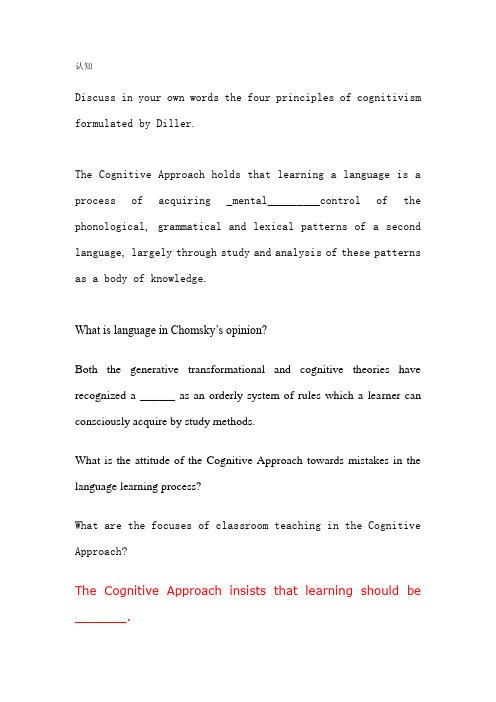
认知Discuss in your own words the four principles of cognitivism formulated by Diller.The Cognitive Approach holds that learning a language is a process of acquiring _mental_________control of the phonological, grammatical and lexical patterns of a second language, largely through study and analysis of these patterns as a body of knowledge.What is language in Chomsky’s opinion?Both the generative transformational and cognitive theories have recognized a ______ as an orderly system of rules which a learner can consciously acquire by study methods.What is the attitude of the Cognitive Approach towards mistakes in the language learning process?What are the focuses of classroom teaching in the Cognitive Approach?The Cognitive Approach insists that learning should be _______.A. groupedB. structuredC. paralleledD. practicedWhat does the Cognitive Approach think about the learner in foreign language teaching and learning?What is the attitude of the Cognitive Approach towards mistakes in the language learning process?What are the procedures followed in a Cognitive Approach classroom?Why does the Cognitive Approach give special importance to the learner’s active part in the learning of grammatical rules? To Piaget, the starting point of cognitive development must be activity on the part of the child, not passive reception of outside ________ .Both the gereative transformatianla and congtive theories have reconiged languge as orderly of _______rules which learner can consciously acquaire by study methodWhat are the generative linguists interested inWhat do assimilation and accommodation refer to in Piaget’s theory of cognitive development?According to the cognitive theory, what are two processes that second language acquisition involves?What significant implications for language teachers do you see in Piaget’s cognitive theory of learning?What are the objectives of language teaching according to cognitive proponentsWhat are the main disadvantages of the Cognitive Approach What are the limitations of the Cognitive Approach?What are the main features of the Cognitive Approach? And in what aspects is the Cognitive Approach different from the Audiolingual Method?By the mid-_________ the upheaval in linguistics and psycholinguistic s created by Chomsky’s transformational-generative grammar had begun to affect language pedagogy.A. 1940sB. 1950sC. 1960sD. 1970sThe generative-transformational school of linguistics emerged through the influence of __________ .A. Noam ChomskyB. J. PiagetC. D. Ausubel D. J.B. BrunerPiaget saw cognitive development as essentially a process of __________ within which genetics and experience interact. A. maturation B. accommodationC. comprehensionD. assimilationChomsky divides the grammar of a natural language into __core________ grammar and peripheral grammar.The Cognitive Approach lays emphasis on innate organizing principles in human perception and _learning_____.The Cognitive Approach holds that students’ mistakes are ______ in the creative use of language.A. usefulB. understandableC. unavoidableD. reasonableThe generative linguist is interested not only in ______ language but also in explaining language.A. teachingB. describingC. usingD. understandingA major feature of _congtive_____ code-learning is the emphasis on explanations of grammatical functioning.The Cognitive Approach lays emphasis on innate organizing principles in human perception and __learning____.Cognitive psychologists hold that language learning is the discovery of the underlying _structure_____ of the language by means of inductive and deductive inference.Chomsky divides the grammar of a _nature_____ language into core grammar and peripheral grammar.The generative-transformational school of linguistics emerged through the influence of ______.A. J.B.BrunerB. N.ChomskyC. D.AusubelD. G.KellyChomsky rejected the behaviorist model of language acquisition on the basis of his model of competence and _performance_____.The process of learning by discovery, according to Bruner, involves _____ with the minimum of instruction and errorful learning.A. generalizationB. associationC. deductionD. inductionThe cognitive theory of learning as put forward by Ausubel is perhaps best understood by contrasting rote and _____ learning.A. usefulB. practicalC. meaningfulD. advancedCognitive psychologists hold that language learning is the discovery of the underlying _____ of the language by means of inductive and deductive inference.The schema theory is an important element in _congtive____ theory. The expression was coined to describe “an active organ ization”.According to D. Ausubel, the principal function of _______ is to act as a bridge between what learners already know and what they need to know.A. schema theoryB. language acquisition deviceC. language competenceD. advance organizersThe Cognitive Approach lays emphasis on the conscious acquisition of language as a meaningful system and it seeks a basis in cognitive psychology and in transformational _grammar______.In the Cognitive Approach, teachers are required to tell the learner about the language, because knowledge of language rules facilitates _learning______.The emphasis on WHAT and HOW continued during the transformational generative period, when the congtive_______ code-learning approach was much discussed.Piaget considers that conceptual growth occurs because the child, while actively attempting to adapt to the environment, organizes actions, into schemata through the processes of assimilation and _accomondation______.In Chomsky’s opinion, linguistic competence refers to the _internized_____ knowledge of the language that a native speaker of that language possesses.A. Linguists concernedB. Contributions to the Cognitive ApproachPiaget considers that conceptual growth occurs because the child, while actively attempting to adapt to the environment, organizes actions into schemata through the processes of assimilation and _accomadation___.In the Cognitive Approach, teachers are required to tell the learner about the language, because knowledge of language rules facilitates learning____.A: the main feature of the Cognitive① It concentrates on the learner’s process② Teachers are required to tell the learner③ It believes that learners play a decisive④ It emphasizes meaningful leaning and⑤ It gives equal importance to all the fourB: the advantage or disadvantage Approach associated with the featurea. Teachers find it difficult to select and of knowing. prepare meaningful presentations.b. The use of the four skills agrees with about the language. the nature of real communication.c. It involves more active use of the role in foreign language learning. students’ mental power.d. It regards language learning as a process practice. of acquiring conscious control of the language rules.e. It is merely proposing a return to the skills. deductive presentation of grammar rules.The process of learning by discovery, according to Brunner, involves ______ with the minimum of instruction and errorful learning.A. generalizationB. associationC. deductionD. inductionThe generative linguist is interested not only indescribing______ language but also in explaining language. Inother words, they attempt to find the what as well as the why in the study of languageAccording to Piaget, thought or thinking has its origin in actions physically performed and then internalized. In other words, thought is _internalized_____ actionsThe generative-transformational school of linguistics emerged through the influence of ________.A. J.B. BrunerB. N. ChomskyC. D. AusubelD. G. KellyThe cognitive theory of learning as put forward by Ausubel is perhaps best understood by contrasting rote and _______ learning.A. usefulB. practicalC. meaningfulD. advancedJean Piaget stated that as the child grows up, his capacity of reasoning______ would become more and more developed through different stages.The Cognitive Approach lays emphasis on the conscious acquisition of language as a meaningful _system_____ and it seeks a basis in cognitive psychology and in transformational grammarChomsky maintained that language is not a form of__behaviour____. On the contrary, it is an intricate rule-based system and a large part of language acquisition is the learning of this system.According to D. Ausubel, the principal function of ______ is to act as a bridge between what learners already know and what they need to know.A. schema theoryB. language acquisition deviceC. language competenceD. advance organizersA major feature of cognitive code-learning is the emphasis on explanations of ______.A. grammatical functioningB. conscious selection of wordsC. deductive order of learningD. language instructionSecond language acquisition, as a complex cognitive skill, involves the processes of _automaticity_____ and restructuring Chomsky rejected the behaviorist model of language acquisition on the basis of his model of competence and _performancd_____ The Cognitive Approach holds that students’ mistakes are_unavoidable_____ in the creative use of language.Why are teachers required to tell the learner about the language in the Cognitive Approach?A. Because knowledge of language rules facilitates learning.B. Because knowledge of language rules is useful for reading and writing.C. Because students’ mistakes can be avoided by learning grammatical rules.D. Because the learning of grammatical rules involves active mental processes.J.B. Bruner believes that learning is most effectively achieved when children are encouraged to ________A. use pre-packaged materialsB. use advice organizersC. engage in individualized teachingD. engage in guided discoveryWhich of the following is NOT a basic principle of the Cognitive Approach?A. Knowledge of language rules facilitates learning.B. Mistakes are unavoidable.C. Teach the language, not about the language.D. Learning is based on understandingThe language acquisition device (LAD) is made up of a set of principles called ____________ grammar.In Chomsky’s opinion, linguistic competence refers to the _________ of the language that a native speaker possesses.()A.inborn deviceB.universal grammarC.internalized knowledgeD.general principlesCognitive Approach holds that students should be led to learn and use the language by making hypothesis, testing the hypothesis ________ and then make corrections.Cognitive Approach holds that mistakes are unavoidable in the creative use of _language_______.A: techniques used in the Cognitive B: the purpose Approach①. discriminationa. to activate oral and written skills②. physical responseb. to develop students’ ability to usethe language independent of the text③. sentence combinationc. to give students practice in listening comprehension④. describing picturesd. to give students practice in telling the difference between linguistic items⑤. prepared speech on a topic of interest e. to give students practice in the use of the grammar rulesBelieve_learner___play a decicive role in theLearning invole organization of materias and should be meaningfulFor Chomsky, linguistic competence refers to the internalized knowledge of the language that a native speaker of that language possesses.()Piaget’s theory of cognitive development holds that the child achieves his conceptual growth through the process of assimilation and ____ Accommodation _________________.The Cognitive Approach seeks in_transformational____________________ Grammar and cognitive psychology a basis for second language teaching7. The revolution in linguistic theory in the 1960s refers to the appearanceof the ____.A. structuralist theoryB. communicative linguisticsC. transformational-Generative GrammarD. habit-formation theory“Teach the language, not about the language”is a principle of ________.A. Communicative ApproachB. Oral MethodC. Cognitive ApproachD. Audiolingual MethodThe cognitive theory of learning as put forward by Ausubel is perhaps best understood by contrasting rote learning and meaningful learning.Chomsky made a difference between the grammatical knowledge and the sentences it produced. He called the knowledge of grammar rules “competence ”.The process of learning by discovery involves induction(taking particular instances and using them to devise a general case ) with the minimum of instruction, and errorful learning .Piaget saw cognitive development as essentially a process of maturation , within which genetics and experience interact..In the opinion of J.B. Bruner, learners should organize knowledge for themselves, forexample, by using(), rather than having materials pre-packaged by the teacher.A. discovery methodsB. advance organizersC. meaningful learningD. cognitive structureAll of the following are the proponents of cognitive psychology except ()A. J.B. Brunner B. D. A. WilkinsC. D. Ausubel D. J. PiagetIn which way is the Cognitive Approach different from the Audiolingual Method?()A. giving the primary stress to listening and speakingB. giving priority to reading and writingC. laying special emphasis on speakingD. giving equal importance to all the four skillsIn 1957, Noam Chomsky published his book __ Syntactic Structures ______ ________.Piaget considers that conceptual growth occurs because the child, while actively attempting to adapt to the environment, organizes actions into schemata through the processes of __assimilation______ and accommodation.The generative linguist is interested not only in __describing______ language but also in explaining language. In other words, they attempt to find the what as well as the _why_______ in the study of language.______ is the author of the book Syntactic Structures.A. Edward SapirB. Noam ChomskyC. J. R. FirthD.M.A.K. HallidayThe generative-transformational school of linguistics emerged through the influence of ______.A. Noam ChomskyB.J. PiagetC. D. AusubelD.J.B. Bruner____ is the process by which we modify what we already know to take into account new information.A. OrganizationB. AccommodationC. ComprehensionD. AssimilationJ. B. Bruner believes that learning is most effectively achieved when children are encouraged to engage in __guided____ discovery.In practice the Cognitive Approach involves more active use of the students' mental power, which is especially suitable for __adult____ language learners.Jean Piaget stated that as the child grows up, his capacity of _reasoning_____ would become more and more developed through different stages.In order to find ways of associating the new materials with ideas or objects with which the pupils are familiar, D. Ausubel would prefer_______.A. straightforward explanation and expositionB. pupil-generated discovery methodsC. rote learningD. inductive and deductive inferenceOf the three procedures followed in a cognitive classroom, which can be viewed as the performance stage?A. Exercises.B. Application activities.C. Introduction of new materials.D. None of the above.Chomsky and others claimed that every normal human being was born with a(n) _______.A. ADLB. LDAC. LADD. ALDThe most important factor that made cognitive psychology dominant in the world is the development of the _computer______ technologyChomsky made the __distinction_____ between linguistic competence and linguistic performance.。
认知教学法 (英语)
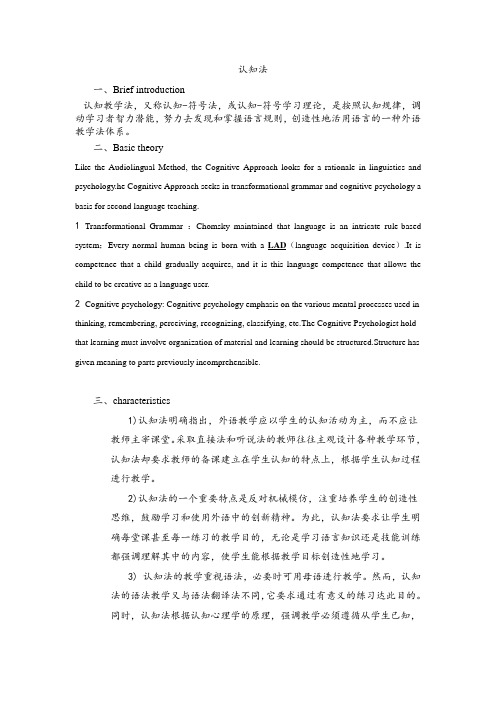
11. To achieve the teaching objectives, the teacher must understand the psychology of the learner.
1. The Cognitive Approach concentrates on the learner’s processes of knowledge rather than on mechanistic procedures imposed upon his by the teacher.
2. At the level of linguistic theory, it signals a rejection of the view that language is external to the mind of the individual.
14. Opportunities should be provided so that students can develop the ability of using the target language through active participation in language communication.
2Cognitivepsychology: Cognitive psychology emphasis on the various mental processes used in thinking, remembering, perceiving, recognizing, classifying, etc.The Cognitive Psychologist hold that learning must involve organization of material and learning should be structured.Structure has given meaning to parts previously incomprehensible.
认知教学法在外语教学中的现代意义

认知教学法在外语教学中的现代意义认知教学法是一种以学习者的认知过程为中心的教学方法。
它注重学生的思维过程和认知能力的培养,旨在帮助学生更好地理解和运用知识。
在外语教学中,认知教学法通过激发学生的思维活动,引导他们主动参与学习,提高他们的学习兴趣和积极性,从而提高学习效果。
现代意义就在于,认知教学法为外语教学注入了新的活力和动力,使得学生能够更快速、更轻松地掌握一门外语。
认知教学法注重学生的认知能力培养,使得他们能够更好地理解和消化新的知识。
在传统的外语教学中,学生往往被 passively 接受知识,他们缺乏主动思考和自主学习的能力。
而认知教学法强调学生的主动参与,鼓励他们通过思考、比较和归纳等认知活动来理解语言知识,从而更深刻地理解语法规则和语言逻辑。
这种认知活动不仅能够提高学生对外语知识的记忆和理解,还能够培养他们的分析和综合能力,使得他们能够更好地应对各种语言环境和交流任务。
认知教学法注重学生的学习策略和技能培养,使得他们能够更有效地运用外语知识。
在外语教学中,学生往往遇到的问题是知识的运用能力比较弱。
他们可能掌握了大量的词汇和语法知识,但在实际交流中却不能自如地运用这些知识。
认知教学法通过教授学习策略和技能,帮助学生更好地理解和掌握语言,让他们能够在实际情境中更有效地运用外语。
它通过让学生进行大量的语言实践和交际活动,培养他们的语言表达能力和沟通技巧;通过教授学习策略,帮助学生更好地整合和利用各种语言资源,提高他们的学习效率和成就感。
认知教学法注重学生的情感态度培养,使得他们能够更积极地面对外语学习。
外语学习是一个长期而复杂的过程,而学生的情感态度和学习动机往往会影响他们的学习效果。
在传统的外语教学中,学生可能因为语言障碍和学习困难而失去信心和兴趣,而认知教学法通过对学生的情感态度进行干预,帮助他们建立积极的学习态度和自信心。
它通过激发学生的兴趣和动力,让他们在学习中享受成功的喜悦,提高他们对语言学习的自信心和兴趣。
英语教学法之认知法
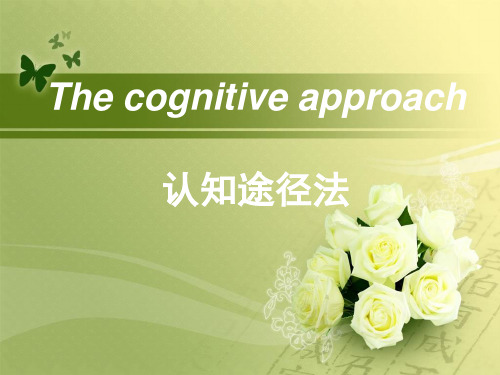
Theory of learning:
1. Cognitive psychology. 2. Deals with the study of the nature and learning of systems of knowledge. 3. Emphasizes on the various mental processes.
The cognitive approach
认知途径法
pproach is an approach to foreign language teaching which is based on the belief that language learning is a process which involves active mental process and not simply the forming of habits.
Background
• As the Audio-lingual Method was on the decline in the 1960s,people tried to find a new method which could meet the new demands in foreign language teaching. • There was a revolution in linguistic theory. • Cognitive psychology studies process of the mind.
Techniques:
• Rule learning • Meaningful practice • Creativity
Exemplification:
• Introduction of new materials • Exercises • Application activities
《外语教学法》第六章 认知法
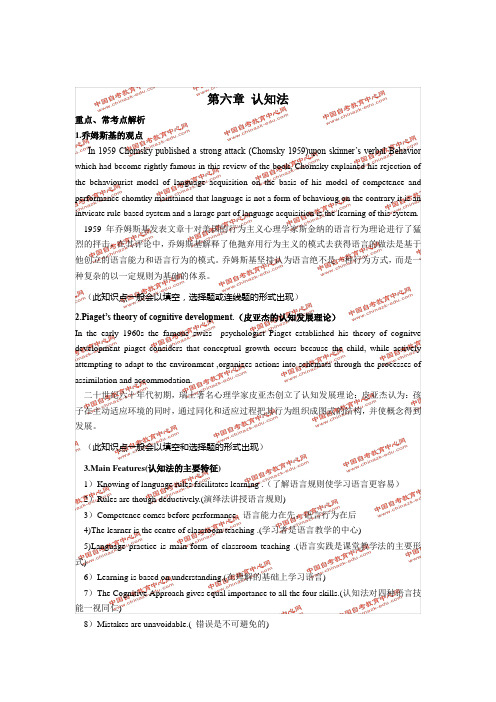
第六章认知法重点、常考点解析1.乔姆斯基的观点In 1959 Chomsky published a strong attack (Chomsky 1959)upon skinner’s verbal Behavior which had become rightly famous in this review of the book, Chomsky explained his rejection of the behaviourist model of language acquisition on the basis of his model of competence and performance chomtky maintained that language is not a form of behavioug on the contrary it is an intvicate rule-based system and a larage part of language acquisition is the learning of this system. 1959年乔姆斯基发表文章十对美国的行为主义心理学家斯金纳的语言行为理论进行了猛烈的抨击,在其评论中,乔姆斯基解释了他抛弃用行为主义的模式去获得语言的做法是基于他创立的语言能力和语言行为的模式。
乔姆斯基坚持认为语言绝不是一种行为方式,而是一种复杂的以一定规则为基础的体系。
(此知识点一般会以填空,选择题或连线题的形式出现)2.Piaget’s theory of cognitive development.(皮亚杰的认知发展理论)In the early 1960s the famous swiss psychologist Piaget established his theory of cognitve development piaget considers that conceptual growth occurs because the child, while actively attempting to adapt to the environment ,organizes actions into schemata through the processes of assimilation and accommodation.二十世纪六十年代初期,瑞士著名心理学家皮亚杰创立了认知发展理论:皮亚杰认为:孩子在主动适应环境的同时,通过同化和适应过程把其行为组织成图式的结构,并使概念得到发展。
英语教学法——认知法
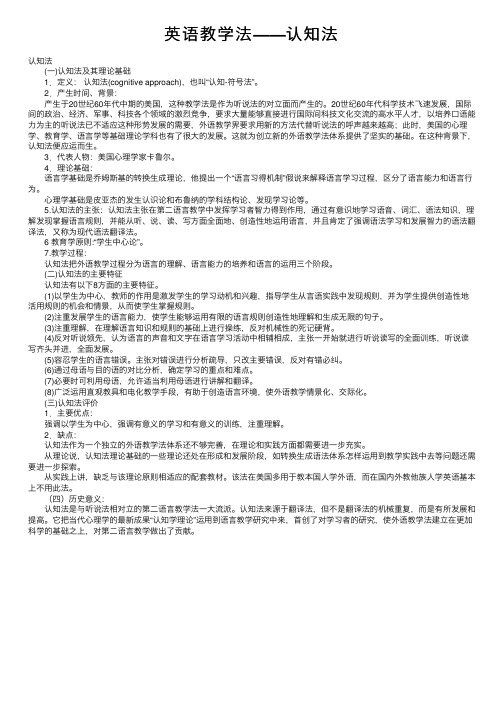
英语教学法——认知法认知法 (⼀)认知法及其理论基础 1.定义:认知法(cognitive approach),也叫“认知-符号法”。
2.产⽣时间、背景: 产⽣于20世纪60年代中期的美国,这种教学法是作为听说法的对⽴⾯⽽产⽣的。
20世纪60年代科学技术飞速发展,国际间的政治、经济、军事、科技各个领域的激烈竞争,要求⼤量能够直接进⾏国际间科技⽂化交流的⾼⽔平⼈才,以培养⼝语能⼒为主的听说法已不适应这种形势发展的需要,外语教学界要求⽤新的⽅法代替听说法的呼声越来越⾼;此时,美国的⼼理学、教育学、语⾔学等基础理论学科也有了很⼤的发展。
这就为创⽴新的外语教学法体系提供了坚实的基础。
在这种背景下,认知法便应运⽽⽣。
3.代表⼈物:美国⼼理学家卡鲁尔。
4.理论基础: 语⾔学基础是乔姆斯基的转换⽣成理论,他提出⼀个“语⾔习得机制”假说来解释语⾔学习过程,区分了语⾔能⼒和语⾔⾏为。
⼼理学基础是⽪亚杰的发⽣认识论和布鲁纳的学科结构论、发现学习论等。
5.认知法的主张:认知法主张在第⼆语⾔教学中发挥学习者智⼒得到作⽤,通过有意识地学习语⾳、词汇、语法知识,理解发现掌握语⾔规则,并能从听、说、读、写⽅⾯全⾯地、创造性地运⽤语⾔,并且肯定了强调语法学习和发展智⼒的语法翻译法,⼜称为现代语法翻译法。
6 教育学原则:“学⽣中⼼论”。
7.教学过程: 认知法把外语教学过程分为语⾔的理解、语⾔能⼒的培养和语⾔的运⽤三个阶段。
(⼆)认知法的主要特征 认知法有以下8⽅⾯的主要特征。
(1)以学⽣为中⼼,教师的作⽤是激发学⽣的学习动机和兴趣,指导学⽣从⾔语实践中发现规则,并为学⽣提供创造性地活⽤规则的机会和情景,从⽽使学⽣掌握规则。
(2)注重发展学⽣的语⾔能⼒,使学⽣能够运⽤有限的语⾔规则创造性地理解和⽣成⽆限的句⼦。
(3)注重理解,在理解语⾔知识和规则的基础上进⾏操练,反对机械性的死记硬背。
(4)反对听说领先,认为语⾔的声⾳和⽂字在语⾔学习活动中相辅相成,主张⼀开始就进⾏听说读写的全⾯训练,听说读写齐头并进,全⾯发展。
认知法
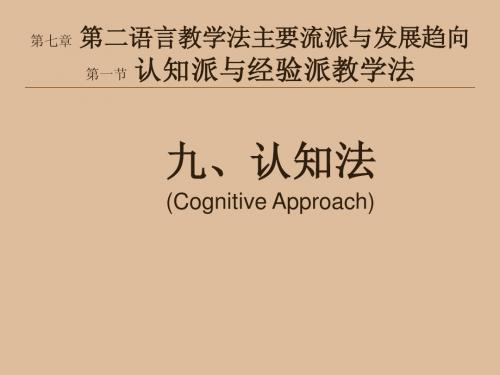
第二语言教学法主要流派与发展趋向
第一节
认知派与经验派教学法
九、认知法
(Cognitive Approach)
一.来源
• 60年代产生于美国 • 代表人物:卡鲁尔 (J.B.Carrol)美国心 理学家。
二.主要内容
1) 主张在第二语言教学中发挥学习者智力作 用,通过有意识地学习语音、词汇、语法 知识,理解、发展、掌握语言规则,并能 从听、说、读、写方面全面地创造性运用 语言。 2) 认知法的主张与听说法相对立,而且又重 新肯定了强调语法学习和发展智力的语法 翻译法,因而被称为“现代语法翻译法”。
四.贡献
1) 认知法从心理学的角度研究第二语言教学, 强调理解和有意义的操练,提倡以学生为 中心,使第二语言教学法走上了更为科学 的发展道路。 2) 认知法运用了听说法的句型操练手段和进 行语言对比方法,基本上继承了语法翻译 法重视自觉掌握语法知识的本质特点,避 免过多的语法知识讲解、过分依赖母语和 翻译。
三.特点
1) 在学习过程中要充分发挥学习者的智力作 用。 2) 强调在理解、掌握语法规则的基础上,进 行大量有意义的联系,提倡演绎法的教学 原则。 3) 以学生为中心,重视培养学生强烈的学习 信心和浓厚的学习兴趣。
4) 听说读写齐头并讲,从开始就进行全 面训练,口语和书面语并重。 5) 适当使用学习者的母语。 6) 正确对待学习着的错误,在学习过程 中出现错误不可避免,对错误进行分 析,采用不同的处理办法。
Байду номын сангаас.缺点
1) 反对有错必纠。 2) 认知法认知法的历史还不长,正在发展之 中,其教学法体系还有待于进行完善。
- 1、下载文档前请自行甄别文档内容的完整性,平台不提供额外的编辑、内容补充、找答案等附加服务。
- 2、"仅部分预览"的文档,不可在线预览部分如存在完整性等问题,可反馈申请退款(可完整预览的文档不适用该条件!)。
- 3、如文档侵犯您的权益,请联系客服反馈,我们会尽快为您处理(人工客服工作时间:9:00-18:30)。
认知Discuss in your own words the four principles of cognitivism formulated by Diller.The Cognitive Approach holds that learning a language is a process of acquiring _mental_________control of the phonological, grammatical and lexical patterns of a second language, largely through study and analysis of these patterns as a body of knowledge.What is language in Chomsky’s opinion?Both the generative transformational and cognitive theories have recognized a ______ as an orderly system of rules which a learner can consciously acquire by study methods.What is the attitude of the Cognitive Approach towards mistakes in the language learning process?What are the focuses of classroom teaching in the Cognitive Approach?The Cognitive Approach insists that learning should be _______.A. groupedB. structuredC. paralleledD. practicedWhat does the Cognitive Approach think about the learner in foreign language teaching and learning?What is the attitude of the Cognitive Approach towards mistakes in the language learning process?What are the procedures followed in a Cognitive Approach classroom?Why does the Cognitive Approach give special importance to the learner’s active part in the learning of grammatical rules? To Piaget, the starting point of cognitive development must be activity on the part of the child, not passive reception of outside ________ .Both the gereative transformatianla and congtive theories have reconiged languge as orderly of _______rules which learner can consciously acquaire by study methodWhat are the generative linguists interested inWhat do assimilation and accommodation refer to in Piaget’s theory of cognitive development?According to the cognitive theory, what are two processes that second language acquisition involves?What significant implications for language teachers do you see in Piaget’s cognitive theory of learning?What are the objectives of language teaching according to cognitive proponentsWhat are the main disadvantages of the Cognitive Approach What are the limitations of the Cognitive Approach?What are the main features of the Cognitive Approach? And in what aspects is the Cognitive Approach different from the Audiolingual Method?By the mid-_________ the upheaval in linguistics and psycholinguistic s created by Chomsky’s transformational-generative grammar had begun to affect language pedagogy.A. 1940sB. 1950sC. 1960sD. 1970sThe generative-transformational school of linguistics emerged through the influence of __________ .A. Noam ChomskyB. J. PiagetC. D. Ausubel D. J.B. BrunerPiaget saw cognitive development as essentially a process of __________ within which genetics and experience interact. A. maturation B. accommodationC. comprehensionD. assimilationChomsky divides the grammar of a natural language into __core________ grammar and peripheral grammar.The Cognitive Approach lays emphasis on innate organizing principles in human perception and _learning_____.The Cognitive Approach holds that students’ mistakes are ______ in the creative use of language.A. usefulB. understandableC. unavoidableD. reasonableThe generative linguist is interested not only in ______ language but also in explaining language.A. teachingB. describingC. usingD. understandingA major feature of _congtive_____ code-learning is the emphasis on explanations of grammatical functioning.The Cognitive Approach lays emphasis on innate organizing principles in human perception and __learning____.Cognitive psychologists hold that language learning is the discovery of the underlying _structure_____ of the language by means of inductive and deductive inference.Chomsky divides the grammar of a _nature_____ language into core grammar and peripheral grammar.The generative-transformational school of linguistics emerged through the influence of ______.A. J.B.BrunerB. N.ChomskyC. D.AusubelD. G.KellyChomsky rejected the behaviorist model of language acquisition on the basis of his model of competence and _performance_____.The process of learning by discovery, according to Bruner, involves _____ with the minimum of instruction and errorful learning.A. generalizationB. associationC. deductionD. inductionThe cognitive theory of learning as put forward by Ausubel is perhaps best understood by contrasting rote and _____ learning.A. usefulB. practicalC. meaningfulD. advancedCognitive psychologists hold that language learning is the discovery of the underlying _____ of the language by means of inductive and deductive inference.The schema theory is an important element in _congtive____ theory. The expression was coined to describe “an active organ ization”.According to D. Ausubel, the principal function of _______ is to act as a bridge between what learners already know and what they need to know.A. schema theoryB. language acquisition deviceC. language competenceD. advance organizersThe Cognitive Approach lays emphasis on the conscious acquisition of language as a meaningful system and it seeks a basis in cognitive psychology and in transformational _grammar______.In the Cognitive Approach, teachers are required to tell the learner about the language, because knowledge of language rules facilitates _learning______.The emphasis on WHAT and HOW continued during the transformational generative period, when the congtive_______ code-learning approach was much discussed.Piaget considers that conceptual growth occurs because the child, while actively attempting to adapt to the environment, organizes actions, into schemata through the processes of assimilation and _accomondation______.In Chomsky’s opinion, linguistic competence refers to the _internized_____ knowledge of the language that a native speaker of that language possesses.A. Linguists concernedB. Contributions to the Cognitive ApproachPiaget considers that conceptual growth occurs because the child, while actively attempting to adapt to the environment, organizes actions into schemata through the processes of assimilation and _accomadation___.In the Cognitive Approach, teachers are required to tell the learner about the language, because knowledge of language rules facilitates learning____.A: the main feature of the Cognitive① It concentrates on the learner’s process② Teachers are required to tell the learner③ It believes that learners play a decisive④ It emphasizes meaningful leaning and⑤ It gives equal importance to all the fourB: the advantage or disadvantage Approach associated with the featurea. Teachers find it difficult to select and of knowing. prepare meaningful presentations.b. The use of the four skills agrees with about the language. the nature of real communication.c. It involves more active use of the role in foreign language learning. students’ mental power.d. It regards language learning as a process practice. of acquiring conscious control of the language rules.e. It is merely proposing a return to the skills. deductive presentation of grammar rules.The process of learning by discovery, according to Brunner, involves ______ with the minimum of instruction and errorful learning.A. generalizationB. associationC. deductionD. inductionThe generative linguist is interested not only indescribing______ language but also in explaining language. Inother words, they attempt to find the what as well as the why in the study of languageAccording to Piaget, thought or thinking has its origin in actions physically performed and then internalized. In other words, thought is _internalized_____ actionsThe generative-transformational school of linguistics emerged through the influence of ________.A. J.B. BrunerB. N. ChomskyC. D. AusubelD. G. KellyThe cognitive theory of learning as put forward by Ausubel is perhaps best understood by contrasting rote and _______ learning.A. usefulB. practicalC. meaningfulD. advancedJean Piaget stated that as the child grows up, his capacity of reasoning______ would become more and more developed through different stages.The Cognitive Approach lays emphasis on the conscious acquisition of language as a meaningful _system_____ and it seeks a basis in cognitive psychology and in transformational grammarChomsky maintained that language is not a form of__behaviour____. On the contrary, it is an intricate rule-based system and a large part of language acquisition is the learning of this system.According to D. Ausubel, the principal function of ______ is to act as a bridge between what learners already know and what they need to know.A. schema theoryB. language acquisition deviceC. language competenceD. advance organizersA major feature of cognitive code-learning is the emphasis on explanations of ______.A. grammatical functioningB. conscious selection of wordsC. deductive order of learningD. language instructionSecond language acquisition, as a complex cognitive skill, involves the processes of _automaticity_____ and restructuring Chomsky rejected the behaviorist model of language acquisition on the basis of his model of competence and _performancd_____ The Cognitive Approach holds that students’ mistakes are_unavoidable_____ in the creative use of language.Why are teachers required to tell the learner about the language in the Cognitive Approach?A. Because knowledge of language rules facilitates learning.B. Because knowledge of language rules is useful for reading and writing.C. Because students’ mistakes can be avoided by learning grammatical rules.D. Because the learning of grammatical rules involves active mental processes.J.B. Bruner believes that learning is most effectively achieved when children are encouraged to ________A. use pre-packaged materialsB. use advice organizersC. engage in individualized teachingD. engage in guided discoveryWhich of the following is NOT a basic principle of the Cognitive Approach?A. Knowledge of language rules facilitates learning.B. Mistakes are unavoidable.C. Teach the language, not about the language.D. Learning is based on understandingThe language acquisition device (LAD) is made up of a set of principles called ____________ grammar.In Chomsky’s opinion, linguistic competence refers to the _________ of the language that a native speaker possesses.()A.inborn deviceB.universal grammarC.internalized knowledgeD.general principlesCognitive Approach holds that students should be led to learn and use the language by making hypothesis, testing the hypothesis ________ and then make corrections.Cognitive Approach holds that mistakes are unavoidable in the creative use of _language_______.A: techniques used in the Cognitive B: the purpose Approach①. discriminationa. to activate oral and written skills②. physical responseb. to develop students’ ability to usethe language independent of the text③. sentence combinationc. to give students practice in listening comprehension④. describing picturesd. to give students practice in telling the difference between linguistic items⑤. prepared speech on a topic of interest e. to give students practice in the use of the grammar rulesBelieve_learner___play a decicive role in theLearning invole organization of materias and should be meaningfulFor Chomsky, linguistic competence refers to the internalized knowledge of the language that a native speaker of that language possesses.()Piaget’s theory of cognitive development holds that the child achieves his conceptual growth through the process of assimilation and ____ Accommodation _________________.The Cognitive Approach seeks in_transformational____________________ Grammar and cognitive psychology a basis for second language teaching7. The revolution in linguistic theory in the 1960s refers to the appearanceof the ____.A. structuralist theoryB. communicative linguisticsC. transformational-Generative GrammarD. habit-formation theory“Teach the language, not about the language”is a principle of ________.A. Communicative ApproachB. Oral MethodC. Cognitive ApproachD. Audiolingual MethodThe cognitive theory of learning as put forward by Ausubel is perhaps best understood by contrasting rote learning and meaningful learning.Chomsky made a difference between the grammatical knowledge and the sentences it produced. He called the knowledge of grammar rules “competence ”.The process of learning by discovery involves induction(taking particular instances and using them to devise a general case ) with the minimum of instruction, and errorful learning .Piaget saw cognitive development as essentially a process of maturation , within which genetics and experience interact..In the opinion of J.B. Bruner, learners should organize knowledge for themselves, forexample, by using(), rather than having materials pre-packaged by the teacher.A. discovery methodsB. advance organizersC. meaningful learningD. cognitive structureAll of the following are the proponents of cognitive psychology except ()A. J.B. Brunner B. D. A. WilkinsC. D. Ausubel D. J. PiagetIn which way is the Cognitive Approach different from the Audiolingual Method?()A. giving the primary stress to listening and speakingB. giving priority to reading and writingC. laying special emphasis on speakingD. giving equal importance to all the four skillsIn 1957, Noam Chomsky published his book __ Syntactic Structures ______ ________.Piaget considers that conceptual growth occurs because the child, while actively attempting to adapt to the environment, organizes actions into schemata through the processes of __assimilation______ and accommodation.The generative linguist is interested not only in __describing______ language but also in explaining language. In other words, they attempt to find the what as well as the _why_______ in the study of language.______ is the author of the book Syntactic Structures.A. Edward SapirB. Noam ChomskyC. J. R. FirthD.M.A.K. HallidayThe generative-transformational school of linguistics emerged through the influence of ______.A. Noam ChomskyB.J. PiagetC. D. AusubelD.J.B. Bruner____ is the process by which we modify what we already know to take into account new information.A. OrganizationB. AccommodationC. ComprehensionD. AssimilationJ. B. Bruner believes that learning is most effectively achieved when children are encouraged to engage in __guided____ discovery.In practice the Cognitive Approach involves more active use of the students' mental power, which is especially suitable for __adult____ language learners.Jean Piaget stated that as the child grows up, his capacity of _reasoning_____ would become more and more developed through different stages.In order to find ways of associating the new materials with ideas or objects with which the pupils are familiar, D. Ausubel would prefer_______.A. straightforward explanation and expositionB. pupil-generated discovery methodsC. rote learningD. inductive and deductive inferenceOf the three procedures followed in a cognitive classroom, which can be viewed as the performance stage?A. Exercises.B. Application activities.C. Introduction of new materials.D. None of the above.Chomsky and others claimed that every normal human being was born with a(n) _______.A. ADLB. LDAC. LADD. ALDThe most important factor that made cognitive psychology dominant in the world is the development of the _computer______ technologyChomsky made the __distinction_____ between linguistic competence and linguistic performance.。
